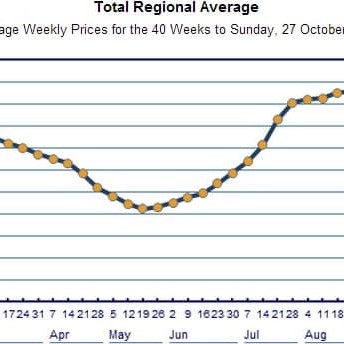Diesel fuel prices have eased only marginally from three-year highs recorded last month, despite the recent rally in currency value.
As can be seen in the graph published below, the strong surge in fuel prices experienced since August has continued, in spite of the recent correction which has seen the A$ again move upwards over the past two months to trade in a band between US93-97c.

Pricing data released by the Australian Institute of Petroleum shows that for the week ended Sunday, October 27, the average retail price for diesel in regional/country areas around Australia was 160.1c/litre, down just 1.1c/litre on where it sat this time a month ago.
That follows nine-month lows seen as recently as May, when prices fell to 148c/litre.
Filling a Toyota Landcruiser 200 series (138 litres, main and auxiliary tanks) today would cost $18 more than the same fill back in mid-May.
Analysts say both diesel and petrol prices could rise further in coming months, due to the imminent seasonal increase in demand for the fuel in China, Europe and North America, which pushes up prices globally. Oil companies use diesel to make heating oil, which adds price pressure as the northern hemisphere heads into winter.
Australia is only about 40pc self-sufficient in transport fuels, meaning international market trends have a direct impact on local pricing.
Regional non-metro diesel prices in the latest AIP report included:
- Victoria 157c/litre (down 1.9c/litre since this time last month)
- NSW 160.2c (down 0.7c)
- Queensland 159.5c (down 1.0c)
- WA 163.5c (down 1.4c)
- SA 159.0c (down 1.0c)
- TAS 165.4c (up 0.1c), and
- NT 176.1c (unchanged).
The prices are calculated as a weighted average of retail diesel fuel for country regions in each state/territory. All values include GST.
Variation in fuel prices can have a considerable impact of cost of production across the Australian beef industry, impacting on livestock transport, cost of shipping in live cattle and boxed beef exports, pumping stock water and providing station electricity in remote locations.
Crude oil, diesel and petrol prices are closely linked, as the price of crude oil accounts for the majority of the cost of producing a litre of petrol or diesel. Crude oil is purchased in US$, meaning that changes in the value of the A$ against the US have a direct impact on the relative price of crude oil in A$ terms.
Why is diesel so expensive, relative to petrol?
Where diesel once traded at a significant discount to petrol, the average price of diesel in recent weeks, above 160c/litre, is up to 20c/l dearer than unleaded petrol at its discount peak, and on-par with premium unleaded fuels. Here’s NRMA’s explanation:
- Diesel is the dominant fuel in Asia and a sharp rise in demand for diesel in India and China has pushed up prices worldwide.
- Demand for diesel in Australia has increased with the mining boom.
- The supply of diesel has not kept pace with the growth in demand.
- The price of diesel is affected by demand for other products it also is used to produce, including jet fuel, kerosene and heating oil.
- Only 25pc of diesel sold in Australia is sold at service stations; the remaining 75pc is bought in bulk by the mining, agriculture and industrial sectors.
